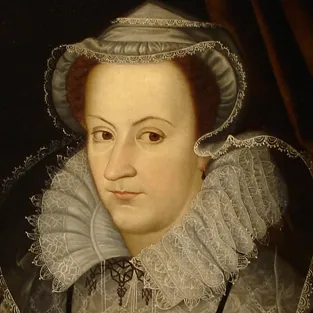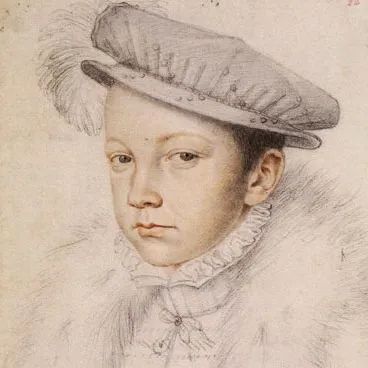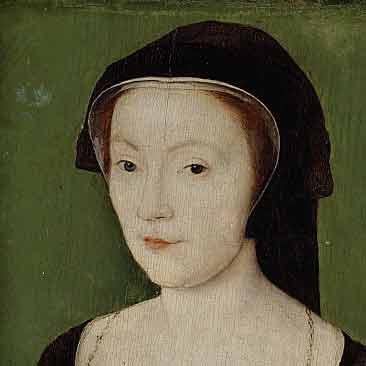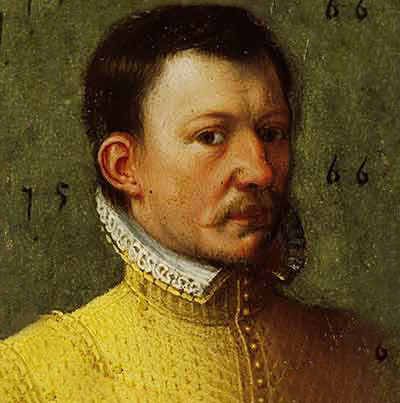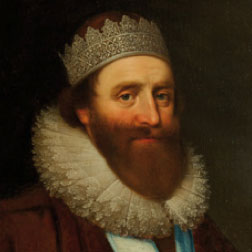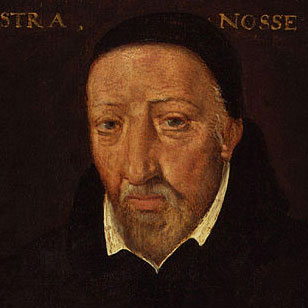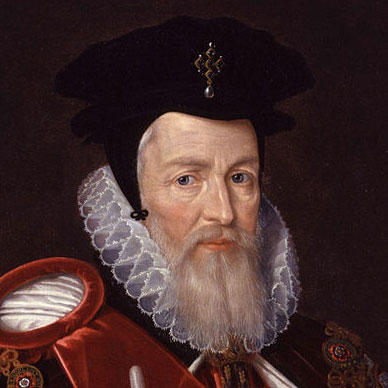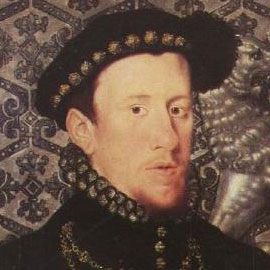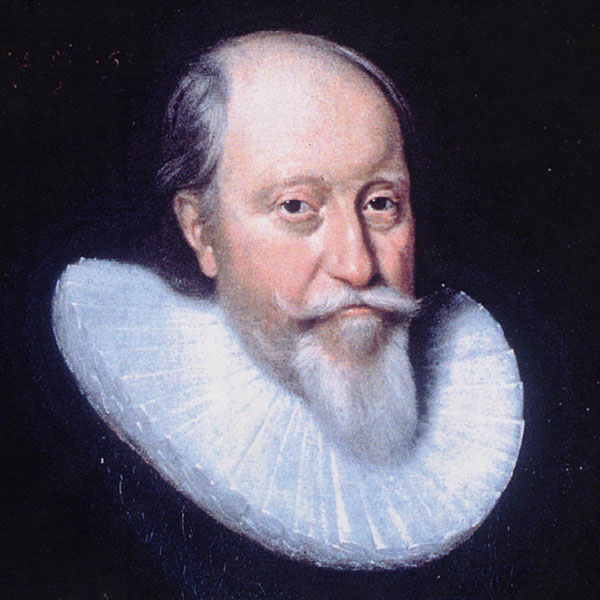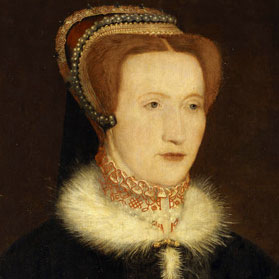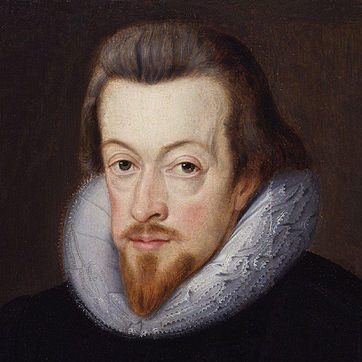Esmé Stuart was born in France, the son of John Stuart, younger brother of Matthew Stuart, 4th Earl of Lennox. For several generations the junior branch of the Lennox Stuarts had lived in France, where they fulfilled illustrious careers as mercenaries and were the traditional captains of the Scottish Gens d’Armes. The title of Seigneur d’Aubigny passed down through this French branch of the family.
In 1579, John Leslie, Bishop of Ross, Mary Queen of Scots’ close adviser, developed a plan for a Counter-Reformation in Scotland, designed to restore her to the Scottish throne and to send James to Europe to be brought up as a Catholic. For audacious daring this was to have no equal among the many attempts that were made to restore Catholicism in Britain, and in Scotland it achieved a measure of success. He had visited the Pope in Rome and received a commission to discuss his plan with Mary’s Guise relations in France. His plan had been to encourage the Earl of Atholl, the only senior Catholic in Scottish Government with access to James, to arrange his kidnap. Yet Atholl had recently died, probably as a result of poison.
The Bishop’s masterstroke was to find the thirty-seven-year-old Esmé as a replacement, while he remained to supervise arrangements from France. Esmé was a close friend of Henri, Duke of Guise, and ‘infinitely Atholl’s superior in ability, address and unscrupulous daring’. As the King’s kinsman, he was immediately more powerful than the other Scottish nobles. He was
handsome, accomplished, courteous and, what was of more importance, while he impressed everyone with the conviction of his honesty, he was one of the adroitest schemers of his time, with almost unmatched powers of dissimulation.
He had secret backing from Philip II, the Papacy and the Guises. The issue for him was to establish sufficient influence over James to achieve their objectives.
Esmé arrived at Leith on 8 September 1579, claiming that he had been summoned from France by James, ostensibly to congratulate the young King on his assumption of Government. Yet this was a well-orchestrated plot to plant a Catholic of influence in place of Atholl in the hierarchy round the King. His secret mission was to find a way to restore Mary to the Scottish throne, and to return Scotland to Catholicism. Esmé was on close personal terms with Lord Livingston and his son, Alexander, even to the extent that there were rumours that Livingston had become a Catholic, and Alexander became one of Esmé’s closest confidantes. Esmé happened to time his arrival when James, accompanied by Alexander, was making his Royal entry into Edinburgh from Stirling after assuming the Government.
Esmé was almost certainly accompanied from France by Patrick, Master of Gray. Gray, who had been taken into the employment of Archbishop Bethune to promote a scheme for the Association, a plan for the joint rule of Scotland by Mary and James. Mary’s advisers had been promoting this for some time. They felt that James, as a dutiful son, would support a plan, the principal objective of which was to obtain her freedom. James was initially enthusiastic about it, as it would result in him being recognised as the Scottish King by the Continental Catholic powers, who hitherto considered that he was usurping his mother’s rightful position. Yet he had already enjoyed a taste for Government, and, with the exception of Esmé, none of his advisers, Protestant or Catholic, saw the Association as offering them advantage.
By chance, another young, charismatic, but unscrupulous new courtier also returned to Scotland in 1579. He was Captain James Stewart, Lord Ochiltree’s second son, who had been a mercenary for the Dutch in the Netherlands. In 1580, James appointed him as a Gentleman of the Bedchamber and Captain of the Guard. It was said of him that ‘for impudent audacity he probably had no equal’. His sister Margaret Stewart had married John Knox, and he sought to ingratiate himself with the Kirk, following his father’s close association with it.
Neither the Master of Gray nor Captain James Stewart was a party to Esmé’s scheme to restore Mary to the Scottish throne. Both were happy enough to hang onto his coat-tails as he rose to influence, but each was out for himself, and there was never any sense of loyalty between them. Yet as they grew in influence, they shared a common goal to bring down the Earl of Morton, attracting a number of the younger lords, like Lord Maxwell and the Earl of Montrose, to their banner.
James, aged thirteen, was completely starstruck by these new arrivals. After being brought up by dour Presbyterians and a rough-hewn bunch of nobles, he suddenly appeared from the schoolroom to find a group of charming, well-travelled, well-educated and attractive men. He was fascinated by them, welcoming his release from the Reformist nobility’s stranglehold. The attraction of these personable and worldly courtiers was a breath of fresh air, and they quickly played on his sensibilities. These new ‘favourites’ were the key to free him from the shackles of the Kirk and his schoolroom. Within a month of Esmé’s arrival, James had agreed to leave Stirling and to take his place at Holyrood, where Esmé reorganised the Court and his household on the French model.
There was more to James’s relationship with these favourites than kicking against his religious upbringing. Their charisma provided a sensual stimulus for him that he was not to enjoy with his interfering and insensitive wife, Anne of Denmark, when they married in 1589. They provided the glamour that he lacked, and there can be little doubt that his homosexuality stemmed from his early attraction to the androgynous Esmé. Well experienced in Court circles in France, Esmé took advantage of the sexual overtures of this vulnerable adolescent, twenty-four years his junior. James would openly clasp him in his arms to kiss him, shocking the Reformist clergy, who saw that Esmé ‘went about to draw the King to carnal lust’, while James showered him with offices and presents. By March 1580, the English ambassador, Bowes, was telling Elizabeth that Esmé was ‘called to be one of the secret counsel, and carryeth the sway in court’. By September ‘few or none will openly withstand anything that he would have forward’.
It should not be assumed that all James’s favourites had homosexual inclinations. Captain James Stewart bedded Atholl’s daughter, Elizabeth Stewart, while she was still the elderly Lennox’s wife, and produced a child by her before she was able to divorce the old man and marry him. They then produced another four children. In 1585, Gray remarried Mary, daughter of Lord Robert Stewart, and she provided him with eight children. Yet by promoting them to positions of political authority, he consciously left the heads of the powerful Scottish houses, who traditionally governed Scotland out in the cold. To achieve this, he treated Esmé as heir to the throne. This would not make the favourites popular.
On 1 June 1580, Esmé showed his extraordinary capacity to dissemble by publicly converting to Protestantism, apparently being persuaded following a debate with James, although in private he advised the Guises that he remained a committed Catholic. David Lindsay, James’s chaplain, was appointed to guide Esmé, whose objective seems to have been to weaken the position of the Earl of Morton, by usurping his position as leader of the Lords of the Congregation. Esmé now started to progress his private agenda, which was not revealed to his fellow favourites, and, with his power growing, he pounced. When the Council met on 16 January 1580/81, he arranged for Stewart to accuse Morton of having planned Lord Darnley’s murder. Morton was seized and, when the King failed to protect him, was imprisoned in Edinburgh Castle to await trial. Two days later, Esmé moved him to Dumbarton. Parliament initially saw the charges against Morton as ‘inventit and forgit of malice’. Although he managed to escape to seek English help, Elizabeth failed to protect him. He was recaptured by Stewart, who escorted back to Dumbarton. Esmé quickly arranged a private Court session to hear the largely trumped up charges. When the Earl of Angus and Sir William Douglas of Lochleven sought to have Morton restored, Esmé had them warded away from Edinburgh.
On 23 May 1581, Stewart and Montrose brought Morton from Dumbarton to Edinburgh for trial. Montrose acted as the Chancellor of the proceedings at the Tolbooth, reading the indictment that accused him of being ‘art and part’ of the King’s murder. On 31 May, Morton was found guilty of treason and he was condemned to be hung and quartered the next day. James commuted this to execution, which took place two days later. Elizabeth was furious with him for failing to protect Morton, and for preferring ‘an Earl of Lennox [Esmé] before a Queen of England’. The English had begun to suspect Esmé’s underlying plan, and Randolph accused him of working with the Guises and the Papacy. Yet they did not realise that he was also scheming to kidnap James and to escort him to Spain. The full plan, which remained secret, was to convert James to Catholicism, and to provide a Spanish princess as his bride. Esmé was to take command of a Spanish force, which with French support would restore Mary as Queen of Scots and ultimately place her on the English throne. His only proviso was that James should remain as joint sovereign in Scotland, in addition to being his mother’s heir. He wrote to Mary: ‘Courage! I ask nothing of you, only that if this enterprise be successful your son should still be acknowledged as King.’ This fitted with Mary’s plan for the Association.
When James held his fifteenth birthday on 19 June 1581, he formally assumed personal rule. On 5 August, Esmé was created Duke of Lennox. To achieve this, James usurped the Lennox Earldom from the elderly Bishop of Caithness, who was created Earl of March in its place. Esmé was granted the estates of the Abbey of Arbroath and, on 11 October, became Lord Chancellor. Stewart was given the attainted Hamilton title of Earl of Arran. Far from being grateful to Esmé for masterminding his extraordinary good fortune, he was beginning to believe the rumours of Esmé’s Catholic scheming. Perceiving himself as the new leader of the Lords of the Congregation, he reopened the traditional conflict between the Hamilton and Lennox claims to be James’s successor. As head of the Hamiltons, he claimed seniority. Yet James backed Esmé.
Believing his position unassailable, Esmé encouraged James to assert his spiritual authority over the Kirk and to appoint bishops. When the Kirk opposed this, he encouraged him to threaten the Kirk with treason. This caused open warfare between the General Assembly and the sixteen-year-old, and it was clear that the Kirk’s stance was aimed at toppling Esmé. It was Esmé, who was blamed for James’s strongly episcopal policy, although this was really no different from that previously espoused by Morton. Esmé was now deeply mistrusted with disastrous consequences for his plans to restore Mary. He still attempt a Catholic coup to gain control of the King and to take him to Dumbarton, possibly en route for France, but the Earl of Mar managed to thwart it by stationing troops at Stirling. Despite this, James continued to trust Esmé, convinced that the widespread rumour branding him the ‘deviser of the erecting of papistrie’ was a ‘malicious’ falsehood.
Mar found himself as the principal opponent of Esmé and his mainly Catholic supporters. Esmé continued to have the ear of the King, who did not appoint Mar, despite their close childhood friendship, to any of the Councils. In August 1582, there were rumours that Esmé was planning to arrest and execute Mar and other Protestant nobles. Through Randolph, Mar sought military help from Elizabeth, but, as ever, she prevaricated, and he was forced to abandon his plans. The Protestant nobles’ lives were at personal risk, and Scotland was in the control of a man seeking to restore both Mary and Catholicism. Somehow Esmé had to be removed, but this required James to be separated from him.
On 15 August 1582, a group of Protestant nobles led by Mar and the Earl of Gowrie kidnapped James in what became known as the Raid of Ruthven and took him to Ruthven Castle, Gowrie’s home. To ensure that Esmé and Arran could not reach him, they surrounded the Castle with one thousand supporters. James was now a prisoner, and he branded Gowrie, who he always disliked, as his jailer. On 23 August 1582, he was presented with a ‘loyal supplication’ on all the wrongs perpetrated by Esmé and Arran. On 24 August, James was permitted to travel to Perth and, six days later, he returned to Stirling. When he asked to join Esmé in Edinburgh, he was told firmly that either ‘the duke or they should have Scotland’ and was taken back to Ruthven in tears of frustration. Esmé had tried to re-establish his position by taking control of Edinburgh, but the Kirk incited such opposition that he had no support. On 26 August, James was compelled to give instructions to expel him from Scotland within fourteen days.
On 5 September, Esmé left Edinburgh apparently for Dalkeith, but he turned west towards Glasgow and Dumbarton. He was accompanied by Lord Seton, who had supported him throughout, and by Alexander, Master of Livingston. On 20 September, he denied all the ‘calumnies’ against him and sent Lord Herries and Mark Kerr, Commendator of Newbottle, to plead his cause, but without success. Yet again he tried to buy time to organise a plot to free the King from Protestant control. James tried to defend him, but the Protestants were having none of it and told him ‘that if he did not cause him to depart he should not be the longest liver of them all’. On the following day Esmé at last left Scotland, accompanied by Seton. They travelled from Dalkeith to London, where Esmé met Mendoza, the Spanish ambassador. He explained that he had had to leave Scotland, as Elizabeth had put pressure on James for his expulsion. As late as 30 November, he was still trying to put together a plot to seize Edinburgh and, on 20 December, sent Livingston to Paris to gain support. He was still in London on 14 January 1583, when he managed to arrange an interview with Elizabeth, who witheringly accused him of every crime that she could think of. Yet he denied any wrongdoing with such conviction that she began to doubt his Catholicism. Walsingham was told to establish his true intentions, but even the spy, who interviewed him, believed him to be a Reformer.
Esmé set off for Paris soon after, but, so long as he had a chance of returning to Scotland, he publicly professed his Protestantism. Once in France, he reported that he had put together another hopeful plan to support a Catholic rebellion to free Mary, but he was by now in poor health. Alexander, Master of Livingston, was with him in Paris, but was sent back to Scotland to tell James that Esmé was terminally ill. He died in Paris on 26 May 1583, aged forty-one. He was buried in Aubigny, but requested that his heart should be sent to James, to whom he entrusted the care of his children. At James’s request, Livingston later returned to France to bring Esmé’s eldest son, Ludovick, now 2nd Duke of Lennox, to Scotland.


